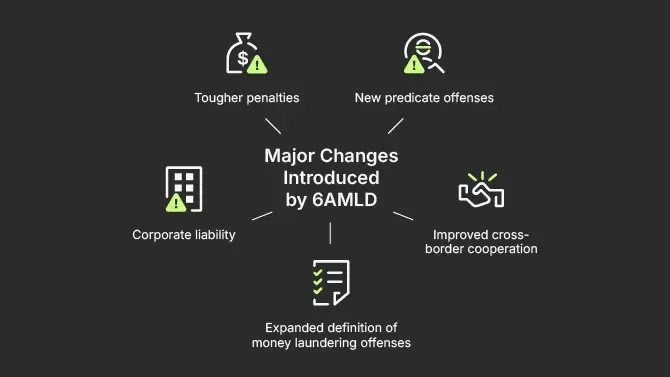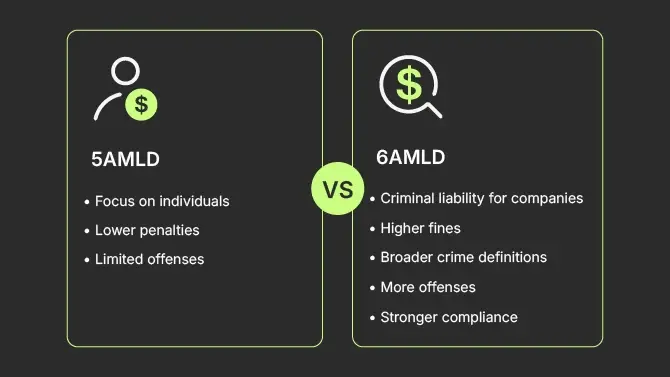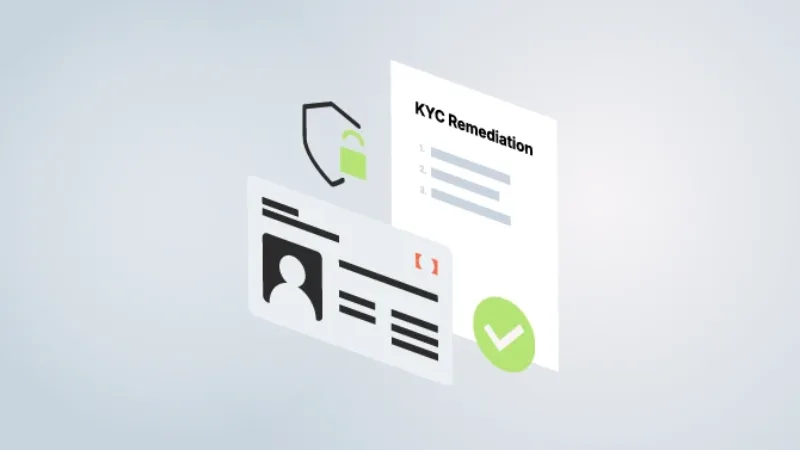The 6th Anti-Money Laundering Directive (6AMLD): What Every Organization Must Know

Money laundering is a pervasive crime that has been plaguing the world for almost its entire history. Its scope is mind-boggling, and its schemes are sophisticated. From corruption and drugs to modern slavery, money laundering continues to sponsor a range of crimes. That’s why regulators are tirelessly fighting back.
The 6th Anti-Money Laundering Directive (6AMLD) – the European Union’s most aggressive response yet – is now enforced and wreaking havoc among fraudsters, money launderers, and other criminals. But how does 6AMLD impact your company’s compliance activities? In this article we will explain what you need to know to stay compliant.
6AMLD Explained
6AMLD was adopted in October 2018 to close loopholes identified after the Panama Papers scandal and other high‑profile cases. The EU member states were required to transpose it into national law by December 3, 2020, and apply it from June 3, 2021.
Unlike the 5th AML Directive (5AMLD), which focused mainly on due‑diligence obligations, beneficial‑ownership registers and risk assessments, 6AMLD uses criminal law to create a more consistent enforcement regime. In particular, it harmonizes the definition of money laundering offenses, sets minimum penalties, and obliges member states to cooperate when crimes cross borders.
$3.1 trillion of illicit funds flowed through the global financial system in 2023, with $346.7 billion linked to human trafficking, $782.9 billion to drug trafficking and $11.5 billion to terrorist financing. Source
Key Objectives of 6AMLD
Bringing the most significant changes to Anti-Money Laundering (AML) compliance in years, 6AMLD has four main goals:
- Harmonizing AML laws – The directive serves as a single rulebook for all EU member states, unifying national definitions and bringing clarity to multinational businesses. Member states must recognize the same 22 predicate offenses (the underlying crimes that produce illicit proceeds) and treat aiding or abetting as criminal offenses.
- Closing legal loopholes – The directive eliminates the “dual criminality” loophole by allowing prosecution even if the predicate offense is not illegal where it occurred. It also makes it harder for criminals to exploit differences in national laws.
- Protecting the financial system – By extending liability to legal persons and mandating tougher penalties, 6AMLD aims to deter criminals and complicit organizations.
- Strengthening cooperation – Member states must support cross‑border investigations, and national authorities are required to interlink beneficial ownership registers, enabling regulators to identify who owns what more quickly.
Major Changes Introduced by 6AMLD

So, what has changed in the European Union’s AML regulations since the 6th Anti-Money Laundering Directive was introduced?
Expanded Definition of Money Laundering Offenses
6AMLD broadens the definition of money laundering beyond the act of disguising “dirty money” – aka illegal proceeds. It now includes aiding, abetting, inciting and attempting to commit money laundering. This means that an employee who assists a client with suspicious transfers, an adviser who helps hide beneficial ownership or a consultant who encourages others to launder funds – each of them can be prosecuted even if no laundering ultimately takes place.
Now, this is a significant change for compliance teams. It means that policies must go beyond direct transaction monitoring to address the risks posed by facilitation and advice. To make sure your compliance officers know how to recognize such situations where their actions could be seen as aiding or inciting illicit activity training should be given.
Corporate Liability
One of the most far‑reaching changes is the extension of criminal liability to legal persons. This means that companies, partnerships and organizations can now face criminal charges too, not just individuals. If someone in a leadership role commits or helps with money laundering, the whole organization can be held responsible. Organizations can also get in trouble if they don’t have proper oversight or controls in place to prevent these crimes.
For example, if top managers don’t put proper safeguards in place and an employee uses company accounts to launder money, both the employee and the company could face charges. Penalties can include hefty fines, being banned from government contracts, or even temporary or permanent closure. All this means company boards need to make anti-money laundering a top priority, hire skilled compliance staff, and make sure everyone knows their responsibilities.
Tougher Penalties
6AMLD mandates minimum prison sentences of four years for people convicted of money laundering offenses. This is a big jump from the previous one-year minimum, showing the EU is getting much tougher on AML crimes. Companies can face large fines and additional sanctions, like being temporarily or permanently banned from doing business, losing access to government funding, or even being forced to close down. These stricter penalties show the EU is serious about cracking down on money laundering.
Improved Cross‑border Cooperation
Money laundering usually happens across multiple countries, so law enforcement needs to work together better. 6AMLD lets prosecutors handle cases in one EU country even when crimes happen in several different countries. It also removes the need for crimes to be illegal in both countries before prosecution, meaning terrorism, human trafficking, or corruption will be treated as predicate offenses no matter where they are committed. Also, EU member states must connect their databases of beneficial ownership information, making it easier for investigators to track who really owns what across Europe. For businesses, this means regulators will have better access to information about international company structures, and beneficial ownership records need to be accurate and current.
New Predicate Offenses
The 6th Anti-Money Laundering Directive lists the following 22 predicate offenses.
The traditional offenses are as terrorism, drug trafficking, human trafficking, arms trafficking, kidnapping, extortion, corruption, fraud, counterfeiting of currency and products, insider trading, market manipulation, bribery, tax crimes and organized crime.
The additions to the directive include new threats such as:
- environmental crimes,
- cybercrime,
- copyright infringement,
- illicit trafficking of cultural goods and nuclear materials,
- sexual exploitation,
- the trafficking of hormonal substances and precursors.
By recognizing environmental and cybercrime, the directive acknowledges the growing importance of ESG issues and digital fraud. Businesses must, therefore, expand their risk assessments to include customers or transactions linked to these new predicate offenses.
5AMLD vs. 6AMLD

The next thing that is important for you to know is the difference between the 5th and the 6th AMLD. Why? Because the 6th anti-money laundering directive introduces much harsher penalties and expanded corporate criminal liability that could seriously impact your business operations and legal risks. Companies that don’t adapt their compliance programs to meet the new requirements could face hefty fines, criminal charges, or even be shut down.
So, let’s compare what’s changed and how to stay compliant.
| 5AMLD | 6AMLD | |
| Focus | – Customer due diligence – Enhanced beneficial ownership registers – Regulating virtual currency exchanges – Prepaid cards and high‑risk third countries | – Criminalized money laundering – Harmonized predicate offences – Aiding and abetting criminalized – Corporate liability – Harsher penalties |
| Scope | Obligated entities include banks, lawyers, real‑estate agents, art dealers and virtual currency exchanges. | Same obliged entities, but liability extends to companies and senior managers, and offences include aiding or inciting laundering. |
| Predicate offences | Not harmonized. Member states could have different lists. | 22 harmonized predicate offences, including cybercrime and environmental crime. |
| Penalties | Minimum one‑year imprisonment for money‑laundering offences. | Minimum four‑year imprisonment and corporate penalties (fines, exclusion from funding, shutdowns). |
| Cross‑border cooperation | Limited; prosecution depended on dual criminality. | Eliminates dual‑criminality loophole; encourages cooperation and single‑state prosecution. |
| Beneficial ownership | Registers established but not necessarily interconnected; verification obligations limited. | Registers must be interconnected, and authorities must continuously verify data. |
Compliance Challenges for Businesses
To effectively combat money laundering and stay compliant to the new AML regulations, businesses should be aware of what challenges they may be facing with the adoption of 6AMLD.
Rising Costs and Penalties
Getting AML compliance wrong can cost businesses huge amounts of money. Worldwide, companies spent $42 billion on AML compliance in 2020 alone, with some banks spending up to $72 million each year. Here are a few examples of such penalties:
- The UK’s online gambling operator „Betway” was fined for allowing £5.8 million in possibly criminal proceeds to pass through, with failures in social responsibility checks.
- The Dutch bank „De Volksbank” was fined €20 million in 2025 for governance and monitoring failures.
- Germany’s the federal financial supervisory authority BaFin fined „Ratepay” (a white label payment services provider for online shops) €25,000 in 2025 for suspected money laundering.
- Vixio, a UK’s provider of regulatory intelligence to the gambling and payments industries, reported over €36 million in AML fines across European financial firms from March 2024 to March 2025, showing the regulatory pressure is intensifying.
The money from fines goes toward new technology, training staff, and monitoring transactions. But it’s not just about money. When AML failures make headlines, they damage your company’s reputation, lose customer trust, and scare off potential investors.
Adapting to Revised Regulations
The 6th AML directive requires businesses to update their procedures in order to handle more types of predicate offenses and new rules about aiding and abetting criminals. This could mean rewriting company policies, updating how you assess risks, and changing your internal control mechanisms. Some industries that now have AML rules for the first time, such as cryptocurrency companies, crowdfunding platforms, luxury goods dealers, and football clubs, may need to create their entire AML compliance programs from scratch.
The new AML regulation brings even more changes, including a €10,000 limit on cash payments and stricter checks on who really owns companies (25% beneficial ownership threshold, or 15% in high-risk industries). Making sure your ultimate beneficial ownership records are accurate and up to date may mean going back through all your existing client files and updating them.
Identity Verification and Know Your Customer
Identity verification remains one of the biggest challenges in AML compliance. Every business (not just financial institutions) needs to verify customer identities and understand the purposes of transactions to stop fraud and other breaches. That’s why implementing strong Know Your Customer (KYC) processes means checking identification documents, using biometric data or facial recognition technology, and comparing information against sanctions and politically exposed persons lists.
With more people working remotely and banking online, it’s become much harder to carry out in‑person Customer Due Diligence (CDD), so companies are relying more on digital verification tools. When KYC checks fail, businesses can face fines and serious damage to their reputation.
Transaction Monitoring and Emerging Products
Ongoing monitoring of transactions to detect suspicious activity takes a lot of time and money. Traditional rules‑based systems can produce large numbers of false positives, while criminals keep getting smarter about hiding their activities. Of course, Artificial Intelligence and machine learning can help catch the real problems more accurately but setting up these technologies costs money and requires specialized knowledge.
New financial products, especially crypto assets, make things even more complicated. Businesses must update their AML programs to monitor digital currency transitions and decentralized finance activities. And, in turn, this means buying new monitoring tools and constantly keeping up with tech innovations.
Opportunities for Organizations
While 6AMLD raises the compliance bar and, as a result, brings about new challenges, it also offers some strategic opportunities for businesses.
Building Trust and Competitive Advantage
Sticking to strict anti-money laundering rules isn’t just about avoiding trouble, it’s about building trust with regulators, investors and, most importantly, your customers. Also, when you show that you’re serious about fighting financial crime and use strong AML controls, you can really stand out. This can give you a real edge over competitors, especially in industries where trust is everything.
Using RegTech and Automation
The right technology can make complex compliance a lot more manageable. The regulatory technology (RegTech) solutions can automate the boring, repetitive parts of the job, like KYC checks, document verification, transaction monitoring, and reporting, thus saving time, reducing the risk of human error, and helping react quicker to regulatory changes. Platforms that integrate customer onboarding, risk scoring, transaction monitoring, and case management offer end‑to‑end compliance with audit trails.
A study by Fortune Business Insights claims that the global RegTech market size is projected to grow from $15.80 billion in 2024 to $85.92 billion by 2032.
Optimizing Processes and Reducing Costs
While investing in modern AML systems might appear costly, it really pays for itself over time. Machine learning and automation help reduce manual work and the number of false positives, which means your team can be more efficient. While centralized data platforms ensure a single source of truth across departments, staying on top of compliance with the help of monitoring tools and risk scoring can help you detect suspicious behaviors quickly and avoid costly fines and penalties down the road.
Access to Markets and Partnerships
Being compliant with 6AMLD can open doors to new markets and business opportunities, because many partners and clients, especially in high-risk industries, now require a strong AML program. So, having one can be the key to landing new contracts and expanding into new markets. Organizations that adopt best‑in‑class solutions, such as those offered by Ondato, can stay compliant while delivering a positive customer experience.
Timeline and Implementation
Here is a chronological timeline of the 6 anti-money laundering directive – a part of a broader EU reform of AML/CFT rules. It is crucial for businesses to understand this timeline now, as they should not wait for the Anti-Money-Laundering Authority (AMLA) to be fully operational before upgrading their AML compliance programs.
| October 2018 | Adoption of 6AMLD by the EU institutions to harmonize AML criminal law and close loopholes. |
| December 3, 2020 | Transposition deadline.Member states had to transpose the directive into national law by this date. |
| June 3, 2021 | Application deadline.Regulated entities were required to comply with 6AMLD from this date. |
| May 30, 2024 | Adoption of the new EU AML package. The European Council and Parliament agreed on a package consisting of a regulation (AMLR), a directive (AMLD 6 – 2024), and the creation of the European Anti‑Money‑Laundering Authority (AMLA). |
| 2025 | AMLA begins operations.The new authority, based in Frankfurt, has started building its capacity in 2025. By 2026‑27 it will directly supervise up to 40 of the largest EU banks and FinTechs, as well as coordinate national supervisors and competent authorities. |
| July 10, 2027 | AMLR applies.The AML regulation, which will be directly applicable across the European Union, will take effect. It will establish uniform CDD rules, beneficial ownership thresholds and reporting obligations, making “light‑touch” regimes a thing of the past. |
Practical Steps Businesses Should Take to Stay Compliant
- Update internal policies and risk assessments. You need to make sure that your AML/CFT policies cover the expanded list of predicate offenses, especially aiding and abetting. You risk assessment protocols should account for new products such as crypto‑assets and high‑risk sectors like luxury goods and football clubs.
- Strengthen governance and accountability. Assign clear responsibility for AML at board and senior management level. Appoint qualified compliance officers, implement escalation procedures and maintain an audit trail of decisions.
- Enhance KYC and due diligence. Use multiple sources to verify customer identities, including document checks, biometrics and database screening. Conduct enhanced due diligence on high‑risk customers and continuously monitor beneficial ownership to meet thresholds (25 % or lower for high‑risk sectors).
- Implement robust transaction monitoring. Adopt AI‑powered monitoring systems to detect unusual patterns across the 22 predicate offenses. Automate risk scoring and use analytics to reduce false positives and identify anomalies.
- Use RegTech solutions. Invest in technology platforms that integrate onboarding, due diligence, monitoring, screening and reporting. Tools like those offered by Ondato deliver identity verification and business onboarding, helping compliance teams to manage all stages of the customer lifecycle. When evaluating solutions, look for global coverage, ease of integration and the ability to configure workflows to meet local requirements.
- Train employees. Provide regular training on the latest AML regulations, including the 6th AMLD and the upcoming AML regulation. Include real‑world case studies and scenarios to illustrate how aiding and abetting offenses can occur and emphasize the importance of reporting suspicious activities.
- Prepare for AMLA supervision. If your organization is large or cross‑border, anticipate possible direct supervision by AMLA. Maintain comprehensive documentation, respond promptly to regulator queries and ensure that group‑wide policies are consistent across EU operations.
- Monitor legislative developments. Stay up to date with the national transposition of 6AMLD, the progress of the 2024 directive and any guidance issued by AMLA. Adapt policies and systems proactively rather than reactively. Participation in industry forums and consultation processes can help businesses stay ahead of changes.
Summing up
People often think that their participation in fighting money laundering is reduced to simply following the rules. But it’s much more than that! By joining this AML fight you help stop serious criminal activities, like fraud, terrorism and trafficking, that harm people every day. To strengthen this collective effort, regulators are stepping up their game too, and the 6th Anti-Money Laundering Directive is a major step forward.
Basically, this new law makes things a lot tougher. It standardizes what a crime is, holds companies accountable, sets stricter penalties, and requires countries to work together. For businesses, this means you can’t just go through the motions. You need a robust plan, including better systems and more reliable technology, to avoid hefty fines and protect your reputation.
By using smart technology, you can actually make compliance easier, build trust with your customers, and even get a leg up on the competition. Now is the time to get your house in order. By doing so, you’ll not only stay on the right side of the law but also help build a safer financial system for everyone.








